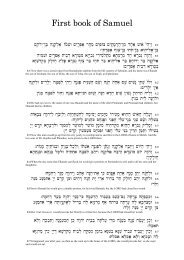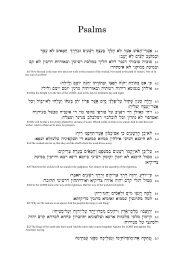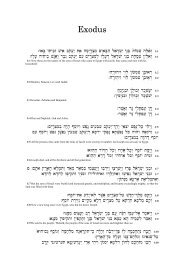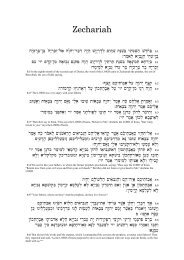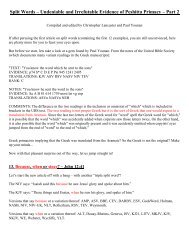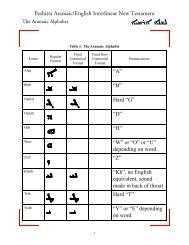- Page 11: text ana translation Societp presid
- Page 15 and 16: REMNANTS OF THE LATEK SYKIAC VERSIO
- Page 17 and 18: 768808 GENEBAL PBEFACE THE contents
- Page 19: REMNANTS OF THE LATER OF THE BIBLE.
- Page 23 and 24: ACKNOWLEDGMENTS IN the task of coll
- Page 25 and 26: CONTENTS ADDENDA ET CORRIGENDA . IN
- Page 27: CONTENTS XI (ii.) Where Greek Text
- Page 30 and 31: XIV ADDENDA ET CORRIGENDA. Page 62
- Page 34 and 35: - xviii INTRODUCTION 2. This defici
- Page 36 and 37: xx INTRODUCTION Biblica (1612), inf
- Page 38 and 39: xxii INTRODUCTION manner and lingui
- Page 40 and 41: xxiv INTRODUCTION above referred to
- Page 42 and 43: xxvi INTRODUCTION (2) In deciding b
- Page 44 and 45: xxviii INTRODUCTION The earliest co
- Page 46 and 47: xxx INTRODUCTION from the Harklensi
- Page 48 and 49: xxxii INTRODUCTION SECTION VII. The
- Page 50 and 51: xxxiv INTRODUCTION On the other han
- Page 52 and 53: xxxvi INTRODUCTION first three and
- Page 54 and 55: xxxviii INTRODUCTION of them prove
- Page 56 and 57: xl INTRODUCTION retained the text o
- Page 58 and 59: xlii INTRODUCTION SECTION XII. AUTH
- Page 60 and 61: xliv INTRODUCTION After Codd. 1 and
- Page 62 and 63: xlvi INTRODUCTION as being the only
- Page 64 and 65: xlviii INTRODUCTION our Four, begin
- Page 66 and 67: 1 INTRODUCTION corrected from the H
- Page 68 and 69: lii INTRODUCTION MS, except the .OO
- Page 70 and 71: liv INTRODUCTION whose text of our
- Page 72 and 73: Ivi INTRODUCTION copy has been inte
- Page 74 and 75: 1'viii INTRODUCTION (a) Of Etzel an
- Page 76 and 77: Ix INTRODUCTION twofold result of t
- Page 78 and 79: Ixii INTRODUCTION witnesses ; where
- Page 80 and 81: Ixiv INTRODUCTION Some of the A-gro
- Page 82 and 83:
Ixvi INTRODUCTION With these may be
- Page 84 and 85:
Ixviii INTRODUCTION more exactly by
- Page 86 and 87:
Ixx INTRODUCTION Greek witnesses se
- Page 88 and 89:
Ixxii INTRODUCTION This eighth Book
- Page 91:
THE FOUR SHORTER CATHOLIC EPISTLES
- Page 94 and 95:
2 MANUSCRIPTS, ETC. 10. Dublin, Tri
- Page 96:
MANUSCRIPTS, ETC. Note that all the
- Page 100 and 101:
8 SUPERSCRIPTIONS, ETC. So 7 and 8,
- Page 102 and 103:
10 PET> L 4~ . l \ _ .oooi2 -CTO 5
- Page 104 and 105:
12 ^a caoO^.l i^Ai-t^i* [2 PET. I.
- Page 106 and 107:
14 *=> Ctoc\ia.i K'v^K' [2 PET. II.
- Page 108 and 109:
16 ^3 Oooi\^.i K'Aii^rc' [2 PET. II
- Page 110 and 111:
the 18 ^ o>cvi\^.l rc'&iX*' [2 PET.
- Page 112 and 113:
20 ..= CK>c\O^.i K'&i-^K' [2 PET. I
- Page 114 and 115:
22 ^ CDOT.I rc'&i^rc' P PET ' IIL 1
- Page 116 and 117:
24 Z= .I-MCU.I K'&v^K' [2 JOH. 4-8
- Page 118 and 119:
26 *= ^CUl rc'&tV' C 2 JoH - 12, 13
- Page 120 and 121:
28 .^ ^J-jjCLi.l K'i-^K' [3 JOH. 5-
- Page 122 and 123:
30 I-MCU.I r^Aii^r* [3 JOH. 12-15 J
- Page 124 and 125:
32 r Vr-SDO) arb: 3 4 6 7 8 10 11 1
- Page 126 and 127:
' V 34 K'.iocn-,.! rfiii^rc' [JuD.
- Page 128 and 129:
36 rc'.iocn-..! rc'^'V^K' [JuD. 15-
- Page 130:
38 The only noteworthy Subscription
- Page 134 and 135:
42 In c, to like effect : (" . . .
- Page 136 and 137:
44 t iwcu:t ^O.^JOK' [ST. JOH. VIII
- Page 138 and 139:
46 {AuCU.! ^oA^jarc' [Si. JOH. VIII
- Page 140 and 141:
[ST. Jon. VIII. 2-7 u i \ t. ^ i uc
- Page 143 and 144:
GREEK TEXT
- Page 145 and 146:
THE FOUR SHORTER CATHOLIC EPISTLES
- Page 147:
EniSTOAAI IIETPOr B, IflANNOT B, mA
- Page 150 and 151:
58 UETPOT B. [2 PET. I. 3-8 I. CLVT
- Page 152 and 153:
60 TIETPOT B. [2 PET. I. 13-19 I. T
- Page 154 and 155:
62 IIETPOT B. [2 PET. II. 4-10 II.
- Page 156 and 157:
64 HETPOT B. [2 PET. II. 14-18 II.
- Page 158 and 159:
66 HETPOT B. [2 PET. II. 22-111. 7
- Page 160 and 161:
68 IIETPOT B. [2 PET. III. 11-16 II
- Page 162 and 163:
70 [2 JOH. 1-5 IQANNOT TOV 'A-TTOCT
- Page 164 and 165:
' 72 inANNOT B. [2 JOH. 10-13 avrbv
- Page 166 and 167:
74 inANNOT P. [3 JOH. 5-10 Trend? &
- Page 168 and 169:
76 IflANNOT P. [3 JOH. 13-15 ov OeK
- Page 170 and 171:
78 IOTAA [JOD. 4-7 yap rt^e? ol Tra
- Page 172 and 173:
80 IOTAA [JuD. 11-15 12 ti;e)(v0r)c
- Page 174 and 175:
82 IOTAA [Jon. 19-23 eicrw ot aTroS
- Page 178 and 179:
The Greek MSS which give the Perico
- Page 180 and 181:
88 KATA IflANNHN [ST. JOH. VIII. 5-
- Page 182 and 183:
90 KATA IflANNHN [ST.JoH.VII.53 VII
- Page 184 and 185:
92 KATA IHANNHN [ST. JOH. VIII. 8-1
- Page 187 and 188:
SUPPLEMENTAL NOTES ON THE ABOVE SYR
- Page 189 and 190:
2 PET. i. 1-4] 97 SUPPLEMENTAL NOTE
- Page 191 and 192:
2 PET. i. 4-5] SUPPLEMENTAL NOTES.
- Page 193 and 194:
2 PET. i. 12-15] SUPPLEMENTAL NOTES
- Page 195 and 196:
2 PET. i. 20-11. 4] SUPPLEMENTAL NO
- Page 197 and 198:
2 PET. ii. 6-10] SUPPLEMENTAL NOTES
- Page 199 and 200:
2 PET. ii. 13] SUPPLEMENTAL NOTES.
- Page 201 and 202:
2 PET. ii. 14-17] SUPPLEMENTAL NOTE
- Page 203 and 204:
2 PET. ii. 19] SUPPLEMENTAL NOTES.
- Page 205 and 206:
2 PET. in. 1-5] SUPPLEMENTAL NOTES.
- Page 207 and 208:
2 PET. m. 10] SUPPLEMENTAL NOTES. 1
- Page 209 and 210:
2 PET. m. 11-16] SUPPLEMENTAL NOTES
- Page 211 and 212:
2Jon. 3-6] SUPPLEMENTAL NOTES. 119
- Page 213 and 214:
2 JOH. 10-13] SUPPLEMENTAL NOTES. 1
- Page 215 and 216:
3JOH. 5-7] SUPPLEMENTAL NOTES. 123
- Page 217 and 218:
3JOH. 10] SUPPLEMENTAL NOTES. 125 T
- Page 219 and 220:
3JoH. 12] SUPPLEMENTAL NOTES. 127 h
- Page 221 and 222:
JUDE 3-4] SUPPLEMENTAL NOTES. 129 a
- Page 223 and 224:
JUDE 7-8] SUPPLEMENTAL XOTES. 131 (
- Page 225 and 226:
JUDE 12] SUPPLEMENTAL NOTES. 133 Ib
- Page 227 and 228:
JUDE 15-23] SUPPLEMENTAL NOTES. 135
- Page 229 and 230:
JUDE 23-25] SUPPLEMENTAL NOTES. 137
- Page 231 and 232:
SUPPLEMENTAL NOTES. 139 to reproduc
- Page 233 and 234:
APPENDIX I. COLLATION OF MANUSCRIPT
- Page 235 and 236:
2 PET. in. 4-2 JOH. 11] COLLATION O
- Page 237 and 238:
JUDE 13-25] COLLATION OF MS. 20. 14
- Page 239 and 240:
2PET.I.3-H.10] COLLATION OF W WITH
- Page 241 and 242:
2 PET. in. 1 3-2 JOH. 12] COLLATION
- Page 243 and 244:
owl I from -MpCLO. | (12) a alone h
- Page 245 and 246:
sometimes writes Greek vowels for t
- Page 247:
SYRIAC VERSIONS OF THE APOCALYPSE.
- Page 250 and 251:
, dycb-T?, 158 INDEX. i, /3ovXo/xeu
- Page 252 and 253:
160 INDEX. t Q g> on 29, 126. : ,m,
- Page 257:
REMNANTS OF THE LATER SYRIAC VERSIO
- Page 260 and 261:
I DESIRE here to express my acknowl
- Page 262 and 263:
ADDENDA ET CORRIGENDA. Page 14, lin
- Page 265 and 266:
INTEODUCTION. SECTION I. Prefatory.
- Page 267 and 268:
INTRODUCTION xi SECTION III. The Ex
- Page 269 and 270:
INTRODUCTION xiii the 4 Kings of th
- Page 271 and 272:
INTRODUCTION xv Thus there are stil
- Page 273 and 274:
INTRODUCTION xvii and his " Second
- Page 275 and 276:
INTRODUCTION xix Prayer of Manasses
- Page 277 and 278:
INTRODUCTION xxi 2. Further, it is
- Page 279:
INTRODUCTION xxiii Ezra, or to trac
- Page 283 and 284:
GEX. xxvi. 26-31] XXVI. ^teh ?] ocn
- Page 285 and 286:
1 CHR. i. 1-n. 7] I. , 2, 3 V\COjj
- Page 287 and 288:
1CHR. in. 5-VI.4] III. 6, 7 8 . K*V
- Page 289 and 290:
1 CHE. vi. 34-49] VI. :i cnva.i . n
- Page 291 and 292:
: rtb\j 2CHB. xxvi. 16-20] 11 > Oft
- Page 293 and 294:
2 CHR. xxx. 1-17] r
- Page 295 and 296:
2 CHR. xxxm. 2-10] 15 XXXIII. v^c c
- Page 297 and 298:
2 CHR. xxxv. 21-25] n=>iva, 7 XXXV.
- Page 299 and 300:
NEH. i. 1-n. 2] 19 fo.65va (line 32
- Page 301 and 302:
NEH. iv. 7-20] fc^Mj.i rsi 21 IV. 7
- Page 303 and 304:
VIII. NEH. vin. 3-10] **.inun ncj 2
- Page 305:
XKH. Tin. 17-ix. 3] Ktin u IT ttlLs
- Page 308 and 309:
PREFATOKY NOTE. THE method of trans
- Page 310 and 311:
30 NOTATION OF MSS AND MSS CITED IN
- Page 313 and 314:
GEN. xxvi. 26-29] 33 r E N E 2 1 2.
- Page 315 and 316:
LEVIT. xxvi. 42-46] 35 XXVI. 42 AEY
- Page 317 and 318:
i CHB. n. 3-13] HAPAAEinOMENnN A. 3
- Page 319 and 320:
1 CHB. in. 2-13] nAPAAEIIIOMENfiN A
- Page 321 and 322:
i CHR. vi. 2-13] UAPAAEinOMENflN A.
- Page 323 and 324:
VI. 1 CHR. vi. 38-49] TlAPAAEIIlOME
- Page 325 and 326:
. XaaOai 2 CHR. xxvi. 16-20] 45 nAP
- Page 327 and 328:
XXIX. 2CHR.xxix.34-xxx.5] HAPAAEinO
- Page 329 and 330:
XXX. 2CHR.XXX.19-XXXIH.2] nAPAAEIlI
- Page 331 and 332:
XXXIII. 2 CHR. xxxni. 7-13] nAPAAEH
- Page 333 and 334:
XXXV. 2CHR.xxxY.20.25] TIAPAAEIIIOM
- Page 335 and 336:
NEH. i. 3-n. 6] NEEMIA. 55 I. eV 6z
- Page 337 and 338:
NEH. iv. 8-19] NEEMIA. 57 IV. 9 'le
- Page 339 and 340:
NEH. vi. 16-vm. 4] NEEMIA. 59 VI. V
- Page 341 and 342:
NEH. viii. 7-12] NEEMIA. 61 VIII. K
- Page 343:
1 NEH. vni. 17-ix. 3] NEEMIA. 63 VI
- Page 347 and 348:
67 SUPPLEMENTAL NOTES. In the attem
- Page 349 and 350:
1 CHB. ii. 3-7] SUPPLEMENTAL NOTES.
- Page 351 and 352:
2 CHR. xxvi. 16-xxxm. 3] SUPPLEMENT
- Page 353 and 354:
2 CHR. xxxm. 3-NEH. ii. 8] SUPPLEME
- Page 355:
NEH. iv. 17] SUPPLEMENTAL NOTES. 75
- Page 358 and 359:
78 INDEX. , 33, 68. ^, Mavacro-^s (
- Page 360:
text and translation Socictp PUBLIC



